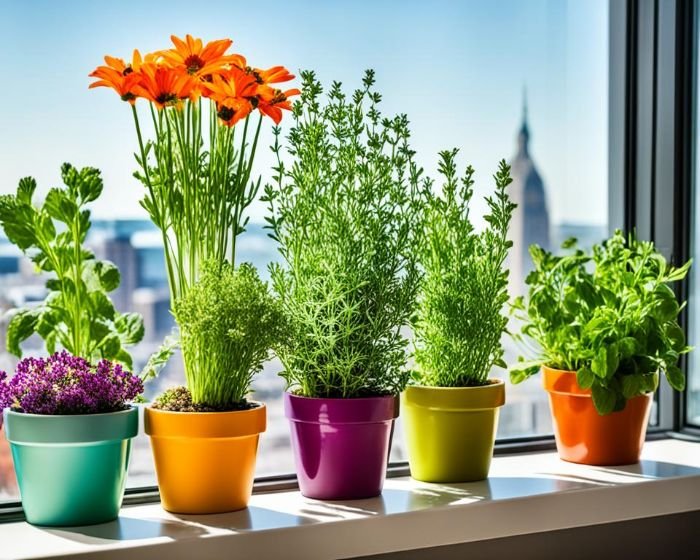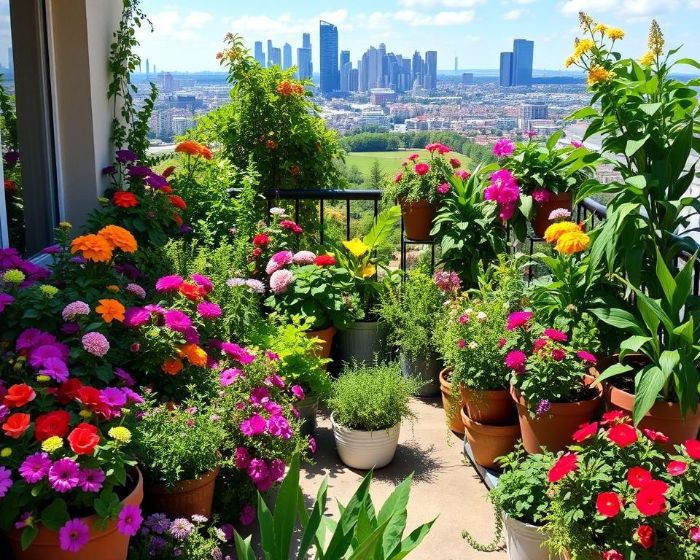Updated October 19, 2025
The first challenge of container gardening isn’t planting – it’s control. Too much sun, water that lingers, or tight roots can stall growth before it begins. Once balance clicks, roots breathe, foliage firms up, and daily care feels effortless. Learn to read moisture and light before you add the first seedling, and you’ll skip most beginner setbacks.
Key Takeaways:
- Spot glossy soil and fix drainage before roots stall
- Place for easy reach so daily care actually happens
- Match plant vigor to volume for calmer moisture swings
- Tune morning checks and a weekly reset for control
- Use light shade at peak heat to protect leaf edges
Table of Contents
Start Here: Minimal Kit and Smart Placement
Container gardening for beginners works best when you start small, keep gear lean, and set pots where watering is easy. Think in terms of a few reliable tools and a safe spot you can reach daily without hauling hoses up stairs.
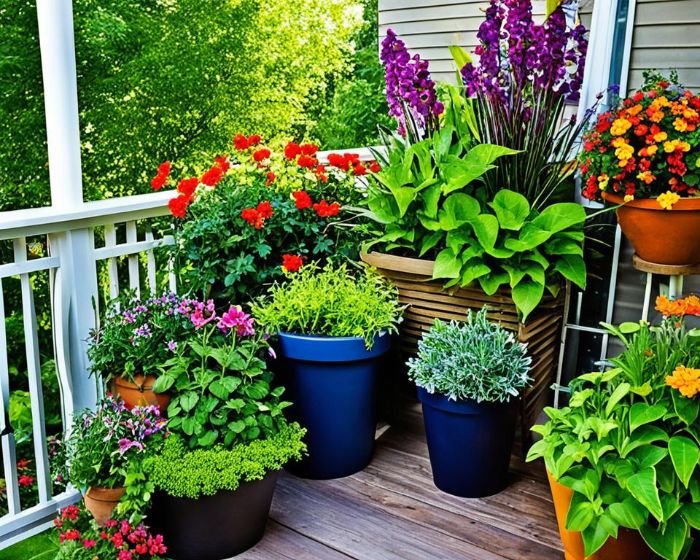
How do I start a container garden?
Begin with one or two medium containers, a quality potting mix, and a simple watering plan. Fill pots three-quarters full, set the plant at nursery height, backfill, and water until excess exits the holes. Place containers where you can reach them without moving furniture and where wind doesn’t tip tall plants.
Pro tip – If you can carry a full watering can from the sink to the pots without stopping, the setup distance is right for daily care.
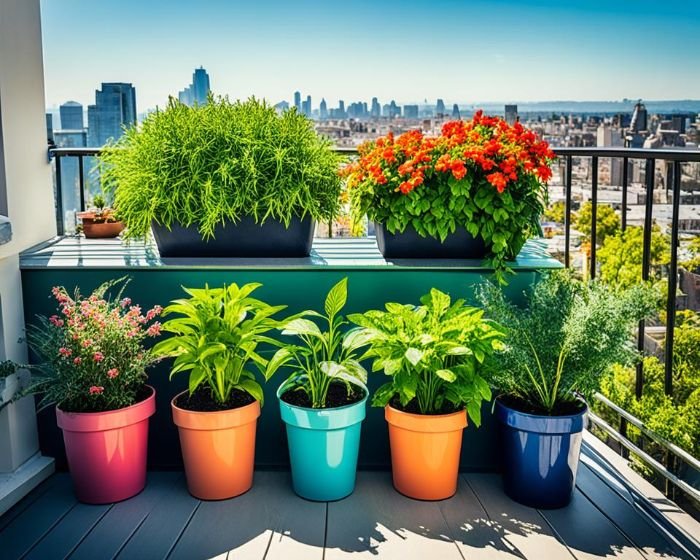
Starter kit checklist
You only need a short list to get growing. Keep it durable and easy to store.
- Two mid-size containers with factory drainage holes
- Saucers that fit without trapping standing water
- Bagged potting mix labeled for containers
- Hand trowel and a narrow-spout watering can
- Plant labels and a permanent marker for dates and varieties
Pro tip – If stairs or long walks are involved, add a lightweight hose with a shutoff near the pots to cut daily effort.
Placement basics
Pick locations you can visit every morning. Access to water beats a perfect view. Keep pots on flat, stable surfaces; use pot feet or blocks to prevent puddling under saucers.
Watch wind. Tall or vining plants act like sails, so tuck them near a railing or wall. Many residential balconies are rated near 40-60 pounds per square foot; spread containers on trays or boards to distribute weight and avoid concentrated loads.
Heat builds fast on dark decks. If leaves droop by late afternoon on hot days, slide pots a few feet to a cooler patch or add a light-colored tray to reduce surface heat.
Wrap-up – A lean kit and reachable placement turn daily care into a two-minute task, which is the real start line for a healthy container setup.
Containers and Drainage: Size, Holes, Saucers
Right-sized containers and working drainage keep roots oxygenated and temperatures manageable. Think volume for vigor, width for stability, and a clean exit path for excess water.
Size selection by plant vigor
Match pot volume to the plant’s growth habit. Compact herbs tolerate small quarters; fruiting crops need more depth and mass for root run and moisture buffering.
If plants wilt by midday and the top third dries within hours, upsize one class. If containers tip in wind, choose a wider pot or add mass at the base with coarse gravel bags sealed in mesh.
Pro tip – When plant height exceeds pot diameter, widen the container; tall foliage acts like a sail and stresses roots during gusts.
Do container gardens need drainage?
Yes. Every outdoor container needs open drainage holes so excess water exits and fresh air can re-enter the root zone after watering.
Aim for multiple holes rather than one large slot. Cover holes with a square of mesh or a shard set flat to stop media loss without blocking flow. Use saucers only to protect surfaces; empty them after each watering to prevent saturated roots.
When to use self watering planters
Reservoir designs help during hot spells or busy weeks. They work best for thirsty annuals and leafy crops that like consistent moisture. Avoid them for drought-tolerant herbs unless the mix is extra airy.
Fill the reservoir, then top-water once after planting to settle media. Keep the fill tube clear and check the indicator daily during heat waves. If leaves yellow from the bottom upward and media stays wet, let the reservoir run down before refilling.
| Habit type | Examples | Minimum volume | Depth target |
|---|---|---|---|
| Compact herbs and flowers | basil, marigold, pansy | 1-2 gal | 8-10 in |
| Leafy greens | lettuce, chard, bok choy | 2-3 gal | 10-12 in |
| Bush vegetables | pepper, bush bean, dwarf tomato | 5 gal | 12-14 in |
| Vining or large fruiting | indeterminate tomato, cucumber, eggplant | 10-15 gal | 14-18 in |
Larger volumes buffer heat and watering gaps, which lowers daily labor. Depth adds anchor and reduces blowover on exposed balconies.
Wrap-up – Choose container volume for plant vigor, guarantee an exit for water, and deploy self watering planters where routine demands it. The roots will breathe, and you’ll spend less time chasing stress symptoms.
Potting Mix, Planting Depth, First Soak
Good root growth starts with a light potting soil, correct crown height, and one thorough settling drink. Get those three right and plants anchor fast without lingering stress.
Why potting soil belongs in containers
Use bagged potting soil formulated for containers. The lighter structure holds moisture while keeping air spaces open, so roots expand rather than stall in heavy particles.
Break up any compressed chunks before filling. If mix dries out between store and home, pre-dampen it in a tub until it clumps when squeezed and falls apart when tapped. Avoid garden soil in pots; dense particles collapse in confined space and starve roots of air.
Pro tip – For hot balconies, blend in a small portion of fine bark or perlite to keep pore spaces open during heat waves.
Planting depth cues
Set the plant at the same line it had in the nursery pot unless you have a clear reason to change. Leaves should clear the rim, and the crown should sit just above the finished surface to prevent rot splash.
Use simple visual checks and stop after each one:
- Rim gap about a finger’s width for clean watering and mulch.
- Crown visible and dry after irrigation rather than buried.
- Tall starts supported at install with a single tie to avoid wobble.
Pro tip – If the transplant leans after watering, add a temporary stake for one week; remove it once new growth locks the root ball.
First soak that settles roots
After backfilling, water slowly across the whole surface so moisture moves through the entire column and exits the base. Pause midway to let air rise, then continue until you see consistent drips from the holes.
Lift the pot slightly from the side to feel weight after the soak. The container should feel noticeably heavier, and the surface should be darker but not soupy. If water pools on top, stop, vent the surface with a narrow tool, and resume at a gentler flow.
Pro tip – I log a quick check the next morning; if the pot still feels very heavy and the top looks glossy, wait before watering again to avoid early root stall.
Wrap-up – A breathable mix, correct crown height, and a deliberate first soak lock roots into fresh media and set up reliable growth in the weeks ahead.
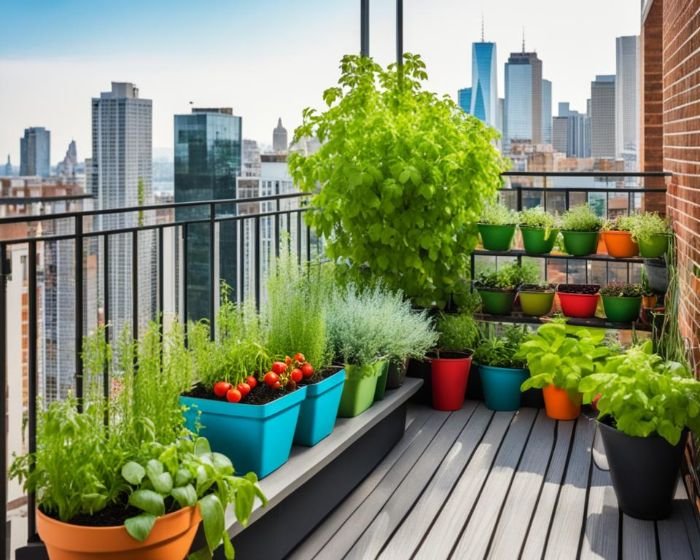
Light Targets and Watering Rhythm for the First Month
Good light and a repeatable watering rhythm stabilize young roots and keep foliage compact. Think morning checks, small course corrections during heat, and a short weekly reset.
Sunlight targets by space
Patios and driveways often pull the most light. Aim for about 7 hours or more where fruiting crops live, with wind breaks to limit leaf scorch. If reflections from siding raise leaf temperature, shift pots a few feet or add a pale tray under containers to cut radiant heat.
Balconies swing with orientation. East balconies favor greens and herbs with 3-5 hours before noon; south and west exposures suit peppers and tomatoes if you buffer late afternoon with a trellis shadow or a light fabric screen. Ground-level stoops rarely get all-day light, so cluster plants at the brightest edge and keep tall pots to the back to avoid self-shading.
Pro tip – Log one light scan on a clear day by the hour. If a location drops below target by early afternoon, rotate in lower-light plants and move high-demand crops closer to the sun path.
Daily moisture checks
Check moisture in the morning when leaves read true. A wooden skewer pushed into the mix should come out cool with a light tint, not muddy. If the top zone has turned pale and the skewer feels dry below mid-depth, water that container.
Water slowly until the surface darkens and moisture reaches the base holes. Pause midway to let air pockets collapse, then finish until you see a brief, even drip from the bottom. On days over 90°F, add a brief mid-afternoon splash for shallow pots and greens; skip that step for deep volumes that still feel cool inside. If surface water beads and refuses to sink, pierce a few channels with the skewer and resume at a gentler flow.
Pro tip – If two pots of the same size dry at different rates, the one with denser canopy gets first priority; broad leaves drive higher use.
Weekly care
Give containers a small reset every 7 days. Turn pots a quarter turn to even out light, then trim crossing shoots and remove tired leaves so air can move through the canopy. Top up with a thin layer of fine bark or fresh mix to reduce splash and moderate afternoon heat.
Scan for salt crust at the rim and rinse it away with a brief flush. Wipe fill tubes on reservoir planters and confirm indicators move freely. If you see droop each evening despite morning watering, step up container volume on the next transplant date or reposition to reduce late-day heat.
Closing thought – A simple morning check, a measured drink, and one weekly tune-up keep container gardening on track without daily firefighting.
Beginner Pitfalls and Fast Fixes
Most early failures trace back to water control, tight roots, and heat exposure. Triage fast, correct one variable at a time, and growth rebounds within a week.
What is the most common mistake made with container plants?
Overwatering leads the list. Water that cannot exit or that arrives too often displaces air and stalls roots.
Open a drain path first. Empty saucers, set pots on feet, and confirm holes are unobstructed with a thin stick. Water in the morning only while recovering. Let the surface lose its sheen and watch for a slight pullback of mix from the pot wall before the next drink. If the container still looks wet 24 hours later, extend the interval and improve airflow under the base.
Pot too small or root-bound
Roots that circle the pot or form a dense mat cause fast dry-down and nutrient stalls.
Upsize by one class, not two, to keep the root ball active. Make three to four shallow vertical slices through the outer mat, tease lightly, and set into fresh media. Support tall growth for a few days to avoid wobble while new roots take hold. If water races through in seconds, you either need more volume or a mix with better structure.
Sun mismatch and heat stress
Afternoon collapse with crisp edges points to excess heat or too much late sun.
Slide pots a few feet to break the beam, or add a pale board under dark decks to cut surface heat. Create a slim shade band with a trellis or fabric screen during the hottest hours. Group smaller containers around a larger one to share shade, and add a thin top-up of fine bark to cool the surface. For reservoir planters, let the tank run lower during a cool spell to avoid cold, wet media.
Symptoms and actions:
- Leaves droop by late day and perk up overnight – move to earlier light window or buffer late sun with a screen.
- Mix stays glossy a day after watering – raise the pot on feet and extend the interval.
- Water pours straight through in seconds – upsize one class and refresh media.
- Brown leaf margins on the sun side – shift 2-3 feet, add a light-colored tray, and thin the densest shoots.
Closing note – Fix drainage first, then container volume, then light and heat. Tackle one change per day so you can see which correction solved the problem.
Practical Wrap-Up
Run containers like a small system and decisions get easier. If foliage runs tall and internodes stretch, increase light by 1-2 hours or move two feet toward the sun path. If a pot feels light by mid-morning and leaves soften before noon, increase container volume one class or tighten your mulch layer. When afternoon readings climb past 90°F, add a brief cooldown drink for shallow pots only; deep volumes should still feel cool beneath the surface.
Set a cadence and stick to it. Do a morning moisture check daily, a quick spin and tidy every 7 days, and a deeper reset at the 4-week mark to reevaluate placement, pot size, and plant mix. If surface crust forms or rims show salt, schedule a gentle flush on the next cool day and elevate bases to improve airflow. I note one performance change at a time so cause and effect stay clear.
Start simple, then scale by pattern. One edible, one herb, one color plant will show you how light, volume, and watering interact on your site. When two out of three grow without daily intervention for two straight weeks, add a new pot using the same rules and position it within 2-3 feet of the best performer.
- Morning check, one action, move on
- Rotate pots weekly to balance light
- Elevate bases to dry faster underfoot
- Upsize one class when dry-down is midday
- Add shade 2-4 pm during heat spikes
FAQs
How many containers should a beginner start with to keep care simple?
Start with two or three mid-size pots so you can track light and dry-down patterns without spreading attention thin. When two pots hold shape between waterings for 24-36 hours and show new growth at the tips, add one more of the same size and place it near the strongest performer.
How do I measure sun hours without special tools?
Pick a clear day and mark sun presence on the spot at the top of each hour from breakfast to dinner. Count only the hours with direct light on the leaves, then confirm on a second day within a week to account for shadows from nearby structures.
What’s a safe way to manage container weight on a balcony?
Spread pots on a rigid board or tray to distribute load, keep the heaviest containers close to support points like walls or posts, and avoid stacking many water-filled planters in one corner. If rain is forecast, empty saucers beforehand so added weight doesn’t arrive all at once.
I can only water every other day. How do I adapt the setup?
Use larger volumes, cluster pots to shade each other, and choose plants with moderate thirst. Reservoir designs help during hot spells; keep the fill tube clear and run the tank lower during cool snaps to prevent soggy media in self watering planters.
Can I reuse potting soil next season, or should I buy fresh?
Reuse is fine if previous plants were healthy. Remove roots and debris, break up clumps, and re-wet evenly before planting. Refresh with a portion of new mix so structure and moisture behavior stay predictable for young roots.
How much potting soil should I buy for a small starter setup?
A 1.5-2 cubic foot bag typically fills two medium round pots or one large planter with a bit left for top-ups. Keep a small reserve sealed for midseason refills after pruning or when settling creates a dip near the rim.
What is a quick success signal in the first week of container gardening for beginners?
New leaf tips appear compact, stems hold their angle through late afternoon, and the pot feels lighter the next morning without leaf droop. That pattern says light and moisture are in range and roots are extending into fresh media.
Is tap water okay for containers, or do I need filtered water?
Tap water works for most setups. If you see white crust at the rim or leaf tip burn, flush with a longer watering on a cool morning and allow full drainage. Where water is very hard, alternate with collected rainwater or a diluted flush to reduce mineral buildup.






